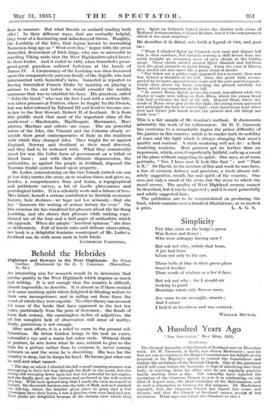Behold the Hebrides
AN interesting aim for research would be to determine that precise quality in the West Highlands which inspires so much bad writing. It is not enough that the country is difficult, almost impossible, to describe. It is almost as if there resided
in it some mocking spirit which delighted in blinding writers to their own incompetence, and in calling out from them the worst of which they were capable. No other theory can account for some of the books that have appeared in the last ten years, particularly from the pens of Scotsmen : the floods of loose lush ecstasy, the meaningless welter of adjectives, the all but complete lack of observation and sense of reality. Truly, patriotism is not enough.
After such efforts it is a relief to come to the present col- laboration. Mr Seton Gordon brings to his task an exact, naturalist's eye and a warm but sober style. Without froth or posture, he sets down what he sees, content to give us the data for a picture rather than to compose it, never coming between us and the scene he is describing. His love for the Country is deep, but he keeps his heal. He knows just what can be said and what cannot.
" The day on which I climbed the hill a small coasting steamer was attempting to force her way through the Kyle to the north, but the strong ebb sweeping down upon her was too powerful for her engine, and she finally gave up the contest and anchored in the still waters of a bay. With each upward step that I made the view increased in beauty. On the south horizon rose the hills of Mull, and as I reached the hill-top, where the heather gives place to grass and a few Ptarmigan have their home, I saw a glorious view over land and sea. Most peaks are delightful because of the distant view which they
give. Sghrr na C6irmich indeed shows the climber wide views of Mull and Ardnamurchan, Coll and Moidart, but it is the near prospect which is the most inspiring."
He describes it in detail, sets forth a legend or two, and goes on :
" When I climbed Sgiirr na Coinnich each near and distant hill was in clear sunshine, but towards evening a chill breeze from the north brought an increasing army of grey clouds to the Cuillin range. These clouds swirled around SgUrr Alasdair and hid from view the great pinnacle on Sgiirr Dearg. From the cone of Blaven they trailed out into space like a great cloud of smoke. " Far below me a golden eagle appeared for a moment, then was lost behind a shoulder of the hill. Soon the great bird, accom- panied by its mate, appeared once more and the pair soared magnifi- cently close above my head, searching the ground carefully for hares, which are numerous on the hill.
" At sunset Beinn Sgriol, across the sound, was aflame while the shades of night were falling on Kyle Rhea, where the young flood tide had overcome the last of the ebb. Beyond Sleat, where the sands of Morar were grey in the dim light, the young moon appeared and prolonged the hour of sunset light—that mysterious hour when past and future join hands across the present and old things are made new."
This is a fair sample of Mr. Gordon's method. It documents admirably the work of his collaborator. Sir D. Y. Cameron has overcome to a remarkable degree the prime difficulty of the painter in this country, which is to render both its nobility of mass and the light which is always changing that mass's quality and contour. A static rendering will not do : a fluid rendering weakens. Most painters get no further than an impression, which, even if superficially faithful, calls up a mood of the place without suggesting its spirit. One says, as of some portraits, " Yes, I have seen X look like that " : not " That is X." Sir David, in the mixture of line and wash he uses here, a line of extreme delicacy and precision, a wash almost infi- nitely suggestive, recalls the real spirit of the country. One sees, not only a mood of the scene, but the scene to which the mood occurs. The quality of West Highland scenery cannot be described, but it can be suggested ; and it is most powerfully and subtly suggested here.
The publishers are to be congratulated on producing the book, which contains over a hundred illustrations, at so modest


























































 Previous page
Previous page